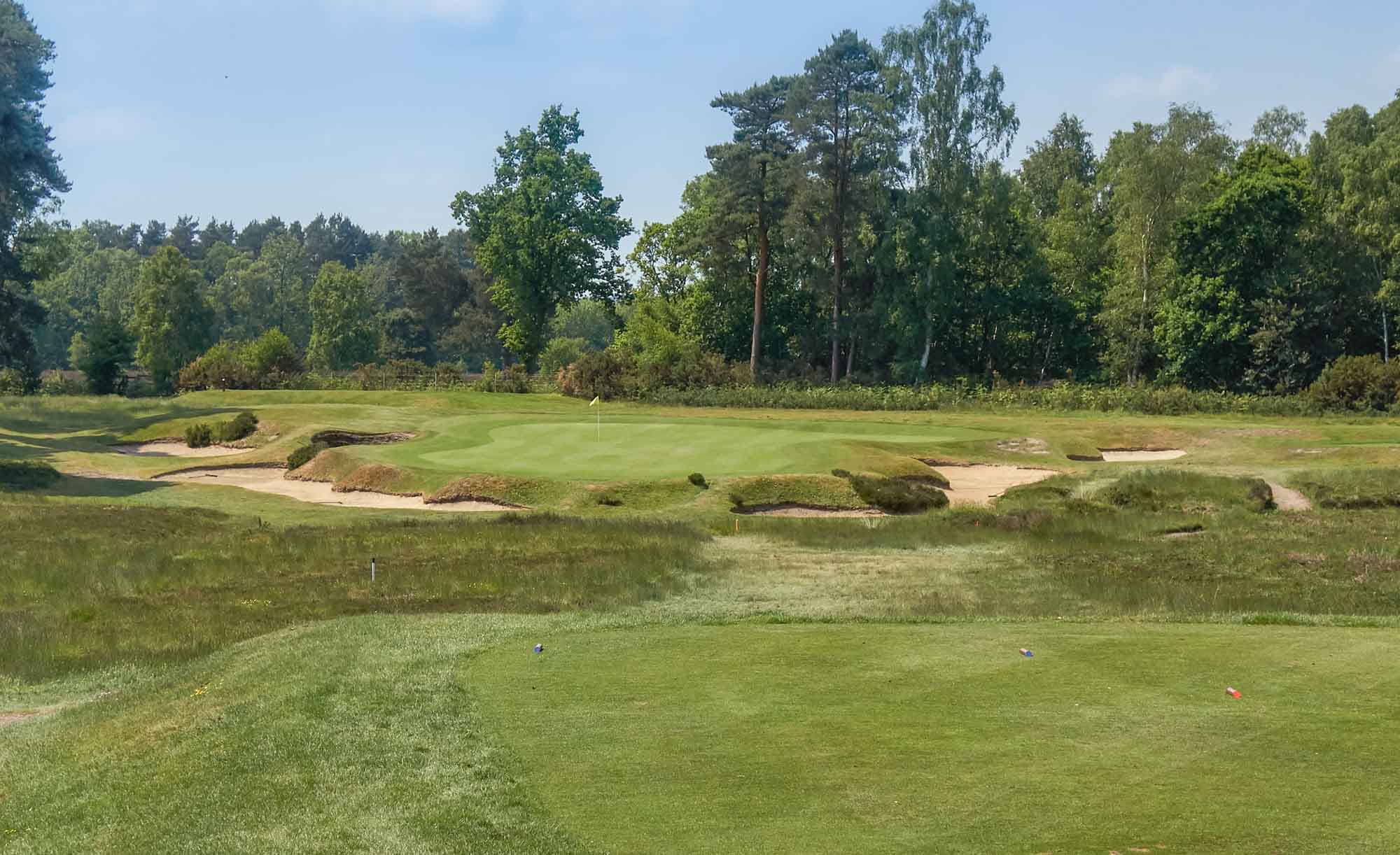Worplesdon Golf Club

Overview
Hailed as a JF Abercromby original, Willie Park Jr was integral to the initial design at Worplesdon Golf Club. Both Arthur Croome and Roger Wethered contributed holes to the course. Mr. Wethered with the 8th in particular and Mr. Croome with the tweaks to the short holes.
In a very real way, JF Abercromby is to Park Jr at Worplesdon Golf Club what Harry Colt is to Willie Park Jr at Sunningdale Old.
Joyce Wethered (Lady Heathcoat Amory) was Lady Captain in 1922 and President at Worplesdon Golf Club from 1963 to 1997!
Golf Course Review
Worplesdon Golf Club is a classic Surrey heathland that sits as one-third of the famous 3W triumvirate. The club was founded in 1908, 15 years after Woking was established as an inland wonder and a year before Cuthbert Butchart's West Hill.
Worplesdon Golf Club History
According to Tom Simpson in the book, The Game of Golf, the original layout and routing at Worplesdon Golf Club were fashioned by Willie Park Jr. with green complexes and bunkering by JF Abercromby. Tom Simpson also hailed the par 5 11th as unbeaten when compared to other 3-shot holes at Sunningdale, Swinley Forest, Worplesdon, and Coombe Hill!
In 1907, it was said that Worplesdon Golf Club was the greatest inland golf course yet to be seen. Others reported it was second only to Sunningdale. This is echoed by reports attributing the design not to JF Abercromby but to Willie Park Jr. (The Globe, 31 July 1914)
By 1920, Worplesdon Golf Club was regarded as "one of the proudest moments of Mr. JF Abercromby's architectural genius" and one of the best golf courses in the British Isles. Indeed, what East Lothian is to Scotland, Woking is to England.
Worplesdon's Significance to Golf Architecture
Worplesdon Golf Club put the golf world on notice and JF Abercromby into the spotlight. Worplesdon Golf Club was called the lastest word on golf course architecture and the appearance of more than two short holes was considered to be revolutionary. (Newcastle Dialy Chronicle 10 March 1909) The course has five Par 3's, nine Par 4's, and four Par 5's. Three of the Par 5's are played in the span of 5 holes on the back nine with two, back to back in 11 and 12.
Herbert Fowler on Worplesdon Golf Club
In 1908, Herbert Fowler applauded JF Abercromby's work at Worplesdon Golf Club. In particular, he noted the raised greens with beautiful slopes and abrupt banks. He described them as 'full of slopes and waves.'
Herbert Fowler revered the 5th and especially its' green. The 7th was called one of the best long short holes he had ever seen. The 8th was known as a template taken from Pandy at Musselburgh. The 11th was considered to be a fine three-shot hole and the 12th an extra-fine two-shot hole. The 15th and 17th greens were also considered highlights. (Sheffield Daily Telegraph 14 December 1908)
Of interest, Herbert Fowler left out the 10th, known as The Pond Hole, which has become the club's 'signature hole' - a short par 3 over Bridley Pond. The first three holes at Worplesdon Golf Club did not escape his candor... calling them 'the blot on the course.'
Arthur Croome & Worplesdon Golf Club
In 1920, Arthur Croome called it the first and one of JF Abercromby's golf architectural masterpieces. It is one of his proudest moments of architectural genius and one of the best courses in the British Isles. (Graphic 21 February 1920) He was the Course Manager and considered to be the best of his day. One critic wrote: 'The fairways are like greens and the green exquisite pieces of velvet.'
Arthur Croome is not usually regarded as a golf course architect but he was responsible for Liphook and was responsible for the changes post WW1 at Worplesdon Golf Club. He admitted the course suffered greatly during the Great War and addressed the changes he made to the short holes. On the 4th hole, a bunker was filled in and a plateau was built into the green and the 10th, known as The Pond Hole, was reconstructed.
He also proposed even greater changes to the 6th, 7th, and 8th. The adopted changes to the 8th are similar to Roger Wethered's (see below) but it would seem Croome was also aligned with Tom Simpson's ethos of strategic minimalism - reducing the number of bunkers from 25 to 7! Although the changes were not adopted, Arthur Croome was more than a Green Keeper and artist, he was very much an enlightened golf course architect.
Roger Wethered & the 8th Hole
The current 8th hole is a Roger Wethered design dating from 1930. JF Abercromby's 8th was universally disliked and thought to be one of the weakest at Worplesdon Golf Club. Width and angles were the name of the game in Roger Wethered's design.
The initial redesign was proposed in about 1930. The hole was put constructed during the winter of 1934/ 35 and put into play in the spring of 1935. With the passage of time, it is interesting to see that the hole in play now is very similar to the originally proposed hole rather than the as-built one.
I had always wondered why Tom Simpson co-authored his book, The Architectural Side of Golf in 1929 with Roger Wethered. After seeing his work at Worplesdon Golf Club from 1930 and its striking similarity to Tom Simpson's ethos of strategic minimalism, it becomes much clearer.
The takeaway point from JF Abercromby's original design? The Principal's Nose bunker complex was borrowed from the 16th at St Andrews and the green was borrowed from Musselburgh. JF Abercromby appreciated the classics and incorporated them into his designs.
Partial Restoration at Worplesdon Golf Club
Recently, Tim Lobb began a restoration of Worplesdon Golf Club. The work started off with a bang in 2021 with the horseshoe bunker on the famous 13th partially restored to its proper place - albeit slightly tamed from its true self. We look forward in earnest to seeing this JF Abercromby restored to its former glory.
Restoration, Renovation, or Combination Thereof?
Another interesting hole to watch will be the 7th. Originally, JF Abercromby designed this short hole after the famous Eden at St Andrews. Arthur Croome explained that the Hill and Strath Bunkers were dug and the cut used to create the slopes on the green. The first iteration proved unsatisfactory.
After WW1, what is meant to be the Strath bunker was enlarged. In the mid-1930s, a diagonal drainage ditch was proposed and dug along with numerous bunkers being converted to heathery-clad depressions. The current green complex has four bunkers but in the past, it had as many as 10!
The current is the version that would have existed after JF Abercromby's death in 1936. The question the club and the architect need to ask and answer is: Do you want an original JF Abercromby, the Arthur Croome version from 1936, or a combination thereof? The same question could be asked of the 4th, 8th, and 10th. From the work done on the 13th, it would appear a full Abercromby restoration isn't the aim of the current work being undertaken at Worplesdon Golf Club...
Worplesdon Golf Club Summary
Worplesdon Golf Club is one of the inland greats. I would tend to agree with Herbert Fowler that the first three holes don't give you a fair preview of what's to come.
I am a big JF Abercromby fan and his characteristic hallmarks are seen here - uphill par 3's and strategic two-shot holes. (see The Addington) He never shied away from the use of elevation (see Knole Park) and the same is true here.
The four holes across the road are simply world-class and the 5th could easily keep the same company. The collection of one-shot holes at Worplesdon Golf Club is superb and as good as his work at Coombe Hill.
Worplesdon Golf Club Reviews

Worplesdon Golf Club - Videos
Watch Worplesdon Golf Club's Promo Video

Featured Architect: MacKenzie, Alister
As taken from his book, Golf Architecture, Alister MacKenzie felt the following were essential: The course, where possible, should be arranged in two loops of nine holes. There should be a large proportion of good two-shot holes and at least four one-shot holes. There should be little walking between...











